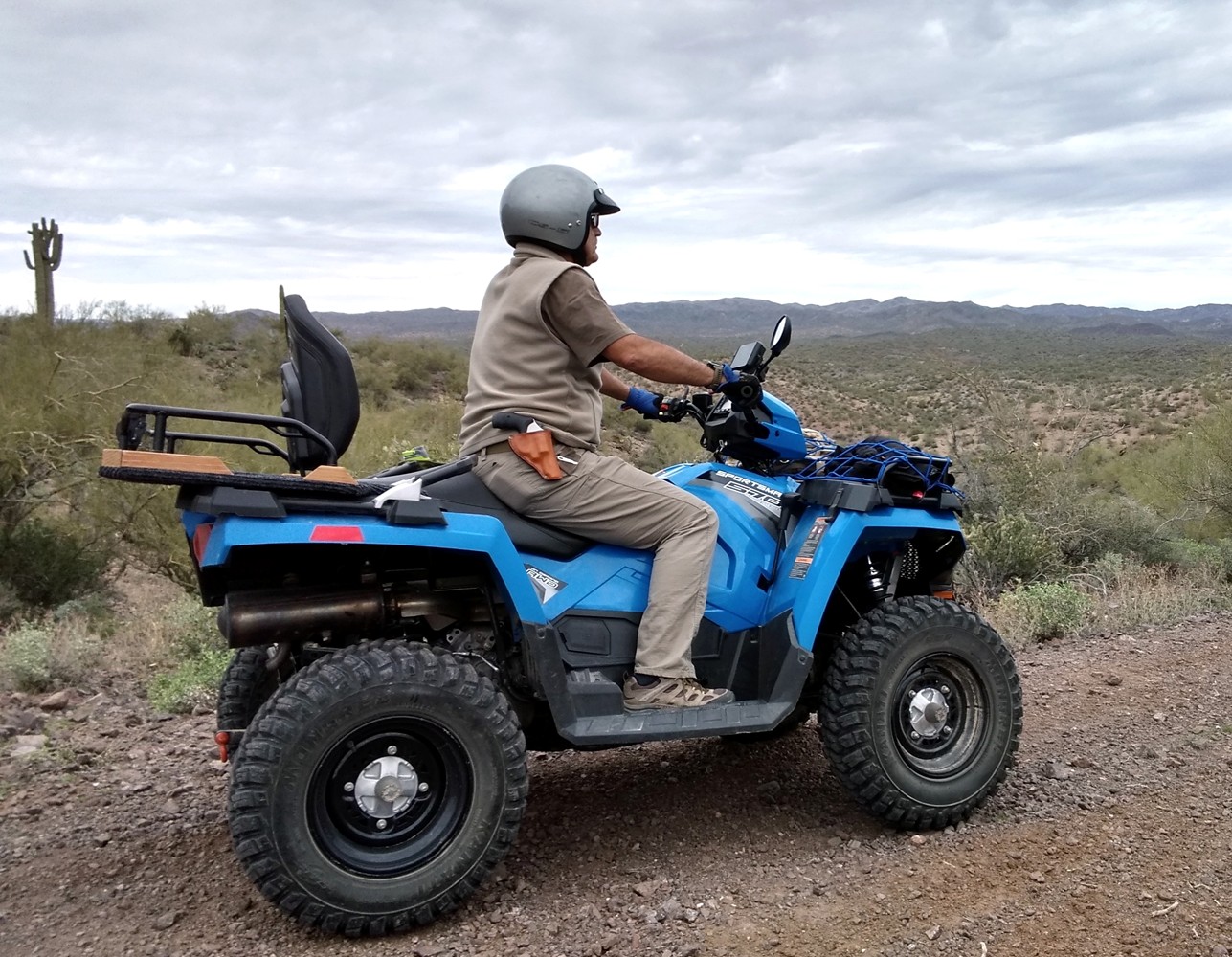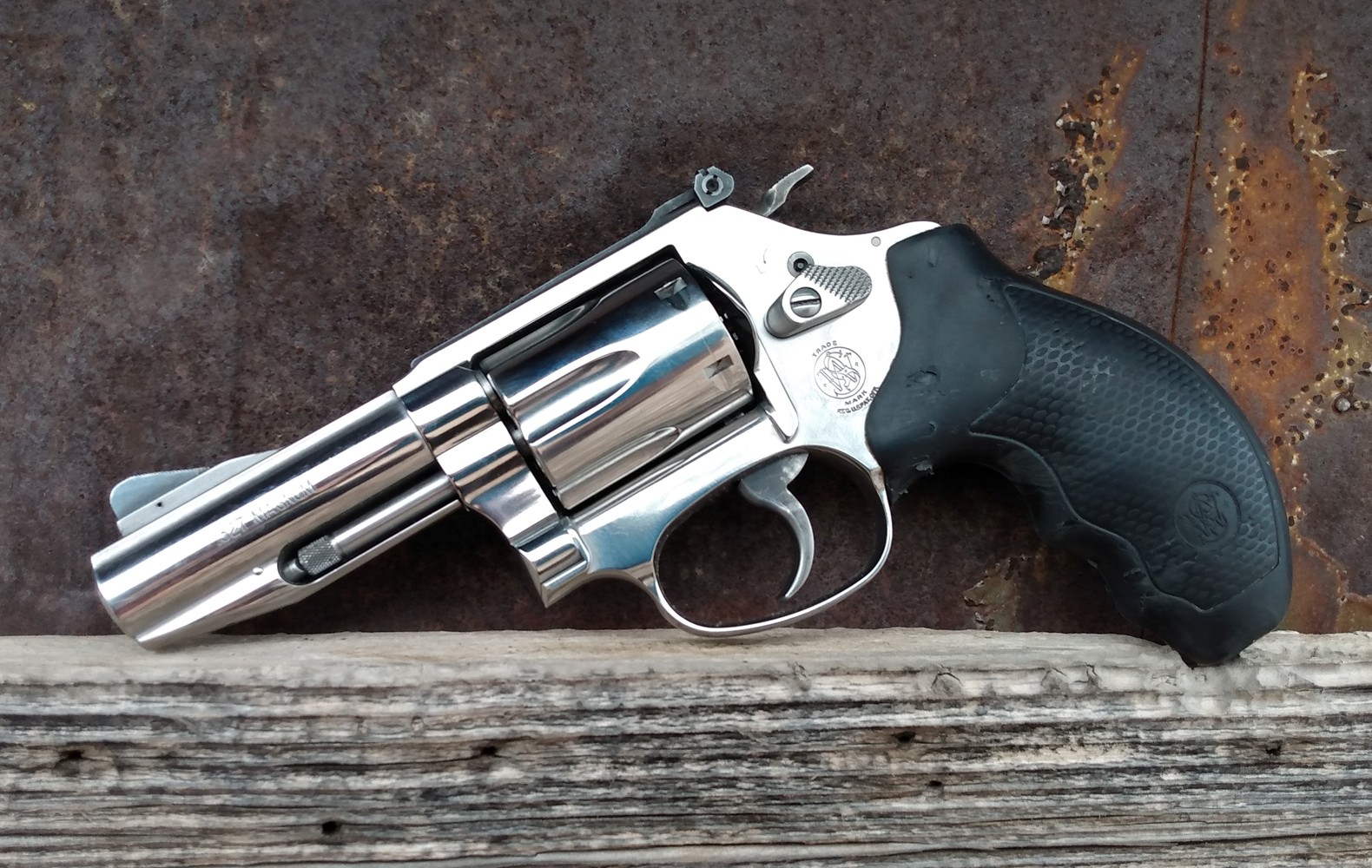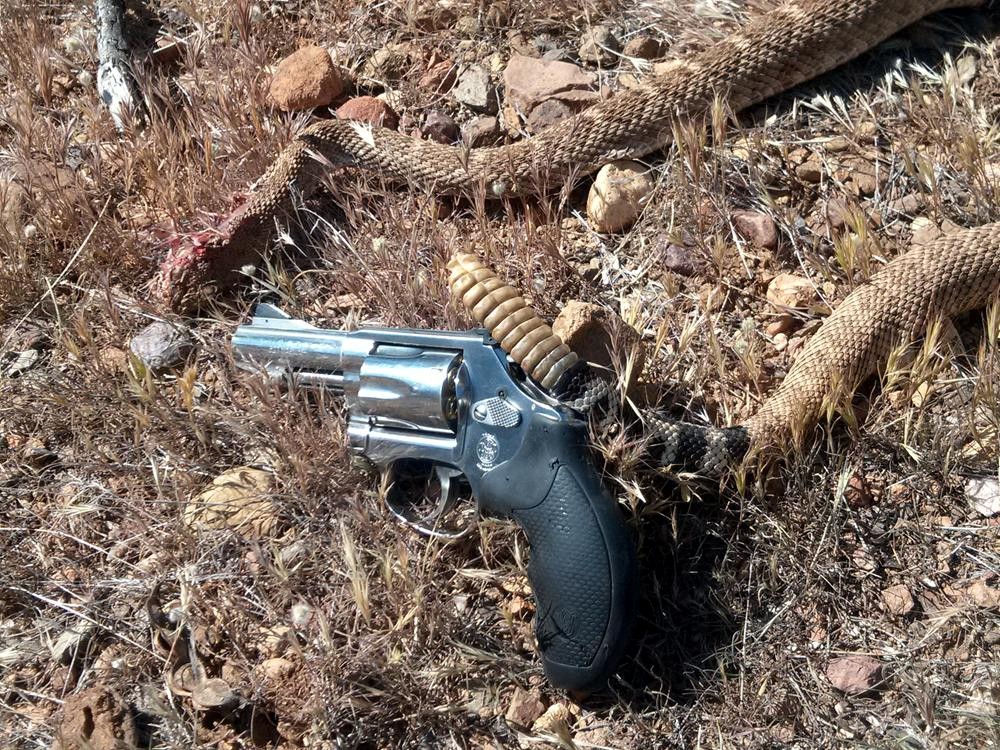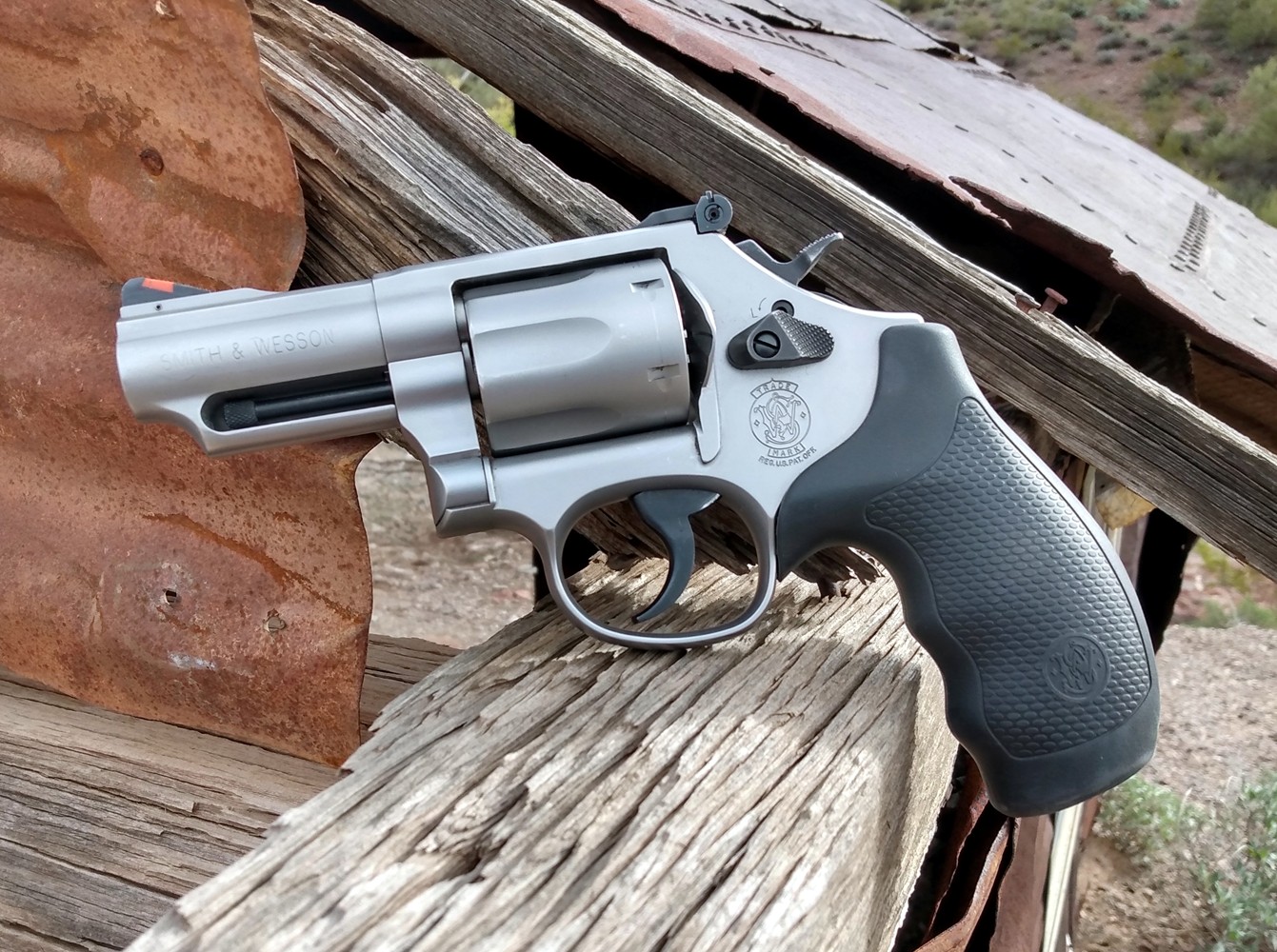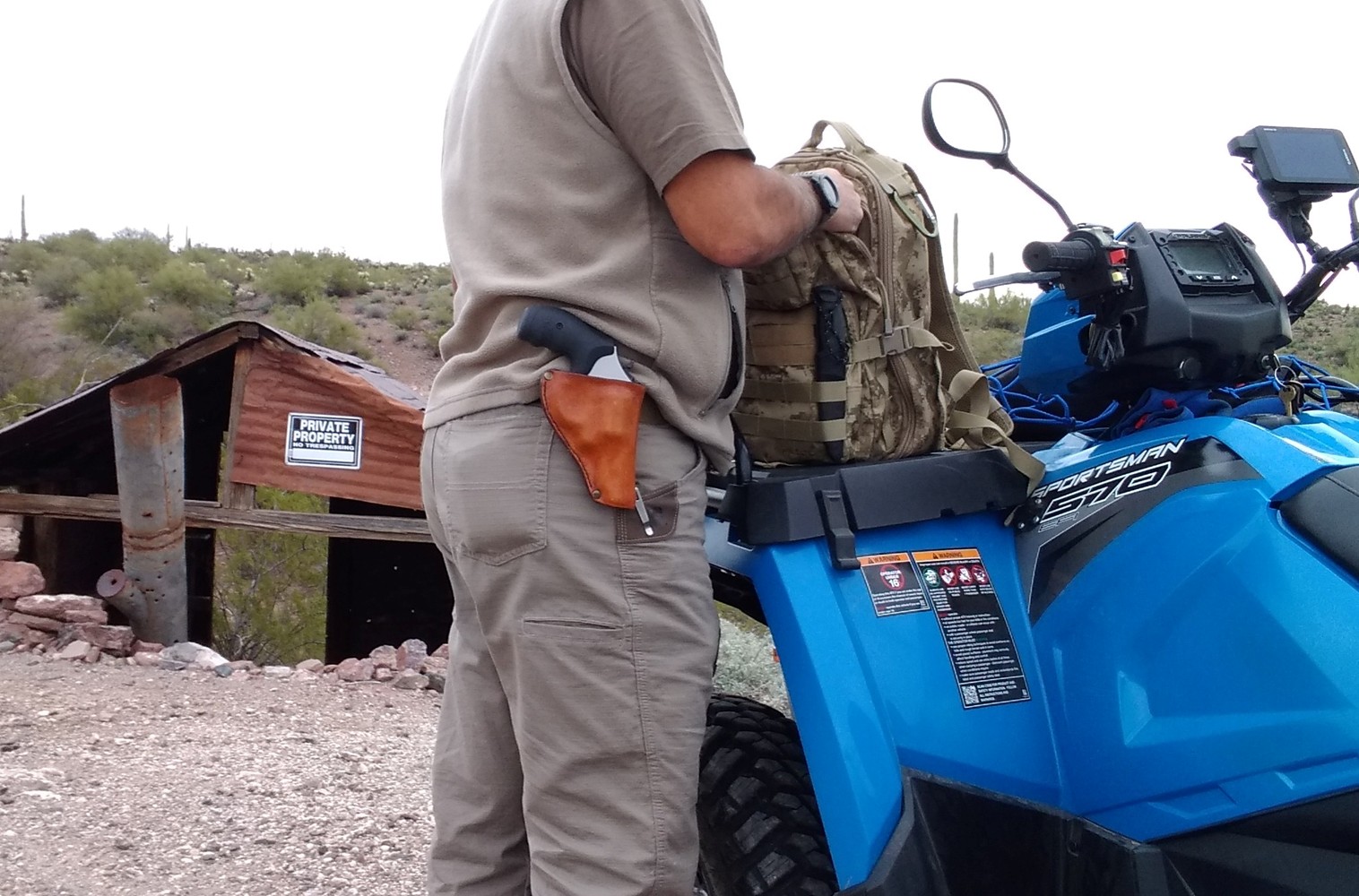One of my favorite genres (?) of firearm is the trail gun. I’ve written
several times now about guns for the camping, for survival, and the trail.
I’ve also mentioned that I have another hobby that I am passionate about
called geocaching, which is a GPS-based treasure hunting game. I specialize
in chasing remote backcountry geocaches – the more remote, the better. This
involves 4x4 roads, ATV trails, and cross-country hiking. Since you never
know what or who you might run into in the deep backcountry (did I just hear
a banjo?),
there is no better companion on these remote excursions than a handy revolver
on your belt.
For a trail revolver, I have several particular attributes that I look for.
First is an adjustable rear sight. I want to be able to fine tune the point
of impact for my favorite handloads.
Second, a trail revolver should have a barrel length of around 3 to 4 inches.
At outdoor distances, you want a decent sight radius so that you can hit what
you are aiming at, but not too long or the gun gets in your way. Your trail
gun is a “just in case” tool. Most of the time you will never fire it while
on the trail, so it needs to be as unobtrusive as possible.
Third, your trail revolver should be relatively light weight. This isn’t as
easy for a revolver, as it might be for a polymer auto-pistol, as most quality
revolvers are hefty chunks of steel. I once owned a 4” Colt Anaconda that I
bought as a trail gun, but I ended up disposing of it (a BIG mistake by the
way for financial reasons) because it was just so heavy on the belt. You won’t
want to wear a gun that is constantly pulling your pants down.
So why a revolver and not a polymer auto-pistol? A big point in favor of a
revolver is ammunition versatility. The three major revolver calibers, .32,
.357, and .44, all have both magnum power, and lower power cartridge choices.
Pick a revolver capable of firing the magnum, and it will also be able to fire
a friendlier, lower power cartridge of the same bullet diameter.
An auto can certainly be just as useful on the backcountry trail as a revolver.
But a revolver evokes the spirit of outdoor adventure in a way that a plastic
pistol just can’t. A revolver has a certain kind of class, and an air of
nostalgia about it.
So let’s talk about three trail revolver picks that meet my selection criteria
and also have that ammunition versatility that makes revolvers perfect as trail
companions.
S&W Model 632 in .327 Federal Magnum
This little J-Frame Smith and Wesson has seen many miles on the trail and in
town with me since I purchased it back in 2012. Today, this gun is basically
unobtainium. I am so glad that I picked it up when I did. It was only
available for a couple of years after S&W introduced it.
I looked for this gun on Gunbroker as I wrote this and I found one, in black
finish, not bright stainless – with an opening bid of $1,850! Holy smokes.
There have been a number of guns that S&W has offered over the years
designated as Model 632, including the earliest which was chambered for
.32 H&R Magnum, not Federal Magnum. That version was introduced before
the Federal Mag came into existence. There was also a snubby version of
the 632 chambered for .327 FM with fixed sights and a shrouded hammer.
The one I own is called the Carry Comp Pro which is the only version of
the 632 that had an adjustable rear sight, which fulfilled my ideal for
a trail gun. There were two finishes offered, black nitride and bright
stainless.
The gun features a 3-inch barrel, but the last one-third of an inch is
an expansion chamber with an open port on top. That’s why the front sight
is set back a little from the end of the barrel and why it is called the
Carry Comp.
Weight is only 23.9 ounces unloaded. I carry this gun in a pancake holster.
With the narrow, rounded butt, it tucks into my side very nicely. It also
conceals well in town with just a T-shirt worn untucked, or a light jacket
or vest.
I typically load it for the trail with .32 H&R Mag cartridges. The .327
Federal Magnum is a very high pressure handgun round. It’s kind of obnoxious,
actually. Do not doubt its potency, as it carries muzzle energy just a hair
less than the .357 Magnum. The .32 H&R is quite comparable to .38 Special in
power level, and is a joy to shoot.
For even milder plinking, it will also fire .32 S&W Long, and the original .32
S&W (short) cartridges. These approximate the power level of .22 LR and can be
good training cartridges, especially for beginners.
Smith & Wesson is making no .32s presently. Their J-frames are only chambered
for .22 LR, .22 Magnum, .38 Special, and .357 Magnum at the moment. In .38 and
.357, the J-frames are all 5-shooters. In caliber .32, the gun is a 6-shooter.
But fear not if you agree with me that the .32 caliber, particularly a revolver
in .327 Magnum is the perfect trail companion. Ruger makes a plethora of
revolvers chambered for .327 Federal Magnum. There are various models in the
SP101, LCR series, the Single Six (Single Seven) series, and even the GP100.
Of these, the one closest to meeting my ideal of a trail gun would be the
adjustable-sighted SP101 with a 4.2” barrel and a fiber optic front sight.
Coming in a close second would be the Single Seven with a 4.6” barrel in either
black or stainless finishes.
Ruger also makes a sweet Single Seven model with a bird’s head grip and a barrel
only 3.75 inches long, but that gun is not equipped with adjustable sights.
Maybe that’s OK.
None of the Rugers are as light and slim as the S&W 632 though. Like I said, I
consider myself very fortunate to have grabbed one while they were available.
S&W Model 66 in .357 Magnum
But what if you think that the .327 Federal Magnum is just too small, or unusual
and difficult to find ammo for? You can’t go wrong with a .357 Magnum.
The Smith & Wesson Combat Magnum is a legend. In its blued form, the Model 19,
introduced in the 1950s, was a favorite with law enforcement during the revolver
era. The Model 66 Combat Magnum in stainless steel was introduced in 1970.
The Models 19 and 66 were built on S&W’s medium size K-frame, but there were
problems. The K-frame could not digest a steady diet of .357 Magnum. If users
trained with .38 Special, but loaded .357 Magnum for duty, there was no issue.
But a steady diet of hot loads led to cracked forcing cones, in particular at the
bottom of the forcing cone where a flat spot was machined due to the yoke design.
The L-frame revolver (Model 686 in stainless, 586 blued) was designed to overcome
these issues. The L-frame, as might be expected, is bigger and heavier, and it
caused the K-frame Model 66 to be discontinued in 2005.
A substantially redesigned Model 66 (the 66-8) was brought back in 2014.
Improvements include elimination of the flat milled at the bottom of the forcing
cone, a new ball-detent front yoke lock-up, and a 2-piece barrel.
Perhaps the most coveted version of the original was the one with a 3” barrel.
The 3-incher was produced in limited numbers and is expensive when found. In
older versions of the Model 66, barrel lengths shorter than 3” did not allow a
full length extractor rod to push empties clear of the cylinder. Due to the new
front of the yoke ball detent lockup, the Model 66-8 with a 2¾” barrel does boast
a full length extractor. I might have preferred this gun to come with a full 3”
barrel, but I guess that 2¾ inches is close enough to make it today’s top choice
for a .357 Mag trail revolver.
Finish is a frosted silver color, not bright stainless. This is set off with
black ejection rod, trigger, cylinder release and hammer. Not flashy, just very
business-like. Weight is 33.4 ounces unloaded, 9.5 ounces heavier than the M632.
When I got it, I was a little disappointed with the trigger action, both in double
action and single action. They were both stiffer than I expected for an S&W.
Other folks on web forums agreed and steered me to a spring kit from Wolff. The
cost was only $15, $20 including shipping. Installation was easy, and greatly
improved the trigger action. That was money well spent.
I carry the M66 in a leather belt holster that I made myself. This was my first
time trying to make a wet-molded holster, and I really like how it came out. Like
the gun, it is not flashy, just business-like, with no ornamentation. It really
hugs the gun and retains it securely. The gun actually snaps into the holster as
it bottoms out. No keeper strap needed.
Taurus Tracker .44
A big hole (!) in my “reference library” was revealed at the recent Big Boar shoot.
Gerhard had a stage where you needed to bring a revolver in a caliber over (not
inclusive of) .357 Magnum. But he offered several alternatives if you did not have
a big bore revolver. I ended up using my .44 Magnum single-shot Lone Eagle, and an
M1911 in .45 ACP. I did fine. Yet, that awakened an itch for a .44 Mag revolver.
Earlier, I mentioned my dissatisfaction with the weight of that 4” .44 Mag Colt
Anaconda that I used to own, and how that led me to divest it from my collection.
When I got my Smith M66, I learned that S&W also offered a similar Model 69 in
.44 Magnum.
Smith & Wesson’s .44 Mags are typically built on the large N-frame (think Dirty
Harry Model 29). No, the Model 69 is not built on a K-frame, but rather on the
L-frame that the Model 686 .357 magnum is built on. But since this .44 is built
on a smaller frame size than its native habitat of the N-frame, the Model 69 is a
5-shooter, not a 6-shot.
However, when I looked at the price of a model 69, I became less enthusiastic
about running out and buying one. The price is comparable to what I paid for the
Model 66, but I wasn’t in that kind of a money-spending mood at the time.
Then somehow, I’m not sure how, I landed on the Taurus web page where I learned
that they had a very similar gun to the Smith Model 69 – a smaller-framed 5-shot
.44 Mag in the Tracker series. I’ve been quite fond of the Taurus Trackers since
I owned one in .357 Magnum. I found it to be quite accurate and of good quality.
The price of a Tracker .44 is on the order of 60% of the price of the S&W Model 69.
So get this: the Tracker .44 weighs in at only 34.8 ounces. Compare that to the
33.4 ounces of the 2¾” Smith Model 66! Slightly larger frame, 4 inch full underlug
barrel - how is this possible? It’s because there is more air inside the bigger
holes of the .44. Is this a trail gun? You bet it is!
Of course low weight has ramifications. I’m not very interested in shooting
full-power .44 Magnum in this gun. Full power .44 Mag has brutal recoil. My
.44 Mag Lone Eagle has a lot of weight (75 ounces) to absorb the recoil of full
house loads, plus it has a full circumference multi-ported rifle-style muzzle
brake on the end of the barrel.
The Tracker .44 has a nominal 4” barrel. But the last 7/8” of the barrel is a
non-rifled expansion chamber with eight upward firing gas ports, four on each
side of the front sight. That will help to mitigate recoil somewhat, but the
low weight of the gun still means stout recoil.
Therefore, I will mostly be shooting this gun with loads in the .44 Special class.
They may be assembled in .44 Special cases, or in .44 Mag cases, but they will not
be full power Mag loads; more like .45 ACP level up to .44 Special +P. I don’t
believe that I will meet any charging Grizzlies here in Arizona.
The stainless steel finish of the Taurus is a duller bead-blast finish than on the
Model 66. In fact, it looks more grey than silver. It may be harder to clean
firing residue off the cylinder and frame as a result. In contrast to the M66,
the extractor rod, the trigger, the cylinder release latch and the hammer are a
brighter shade of silver than the frame.
Trigger action in both double and single action is smooth, crisp, and light enough.
No spring changes are needed.
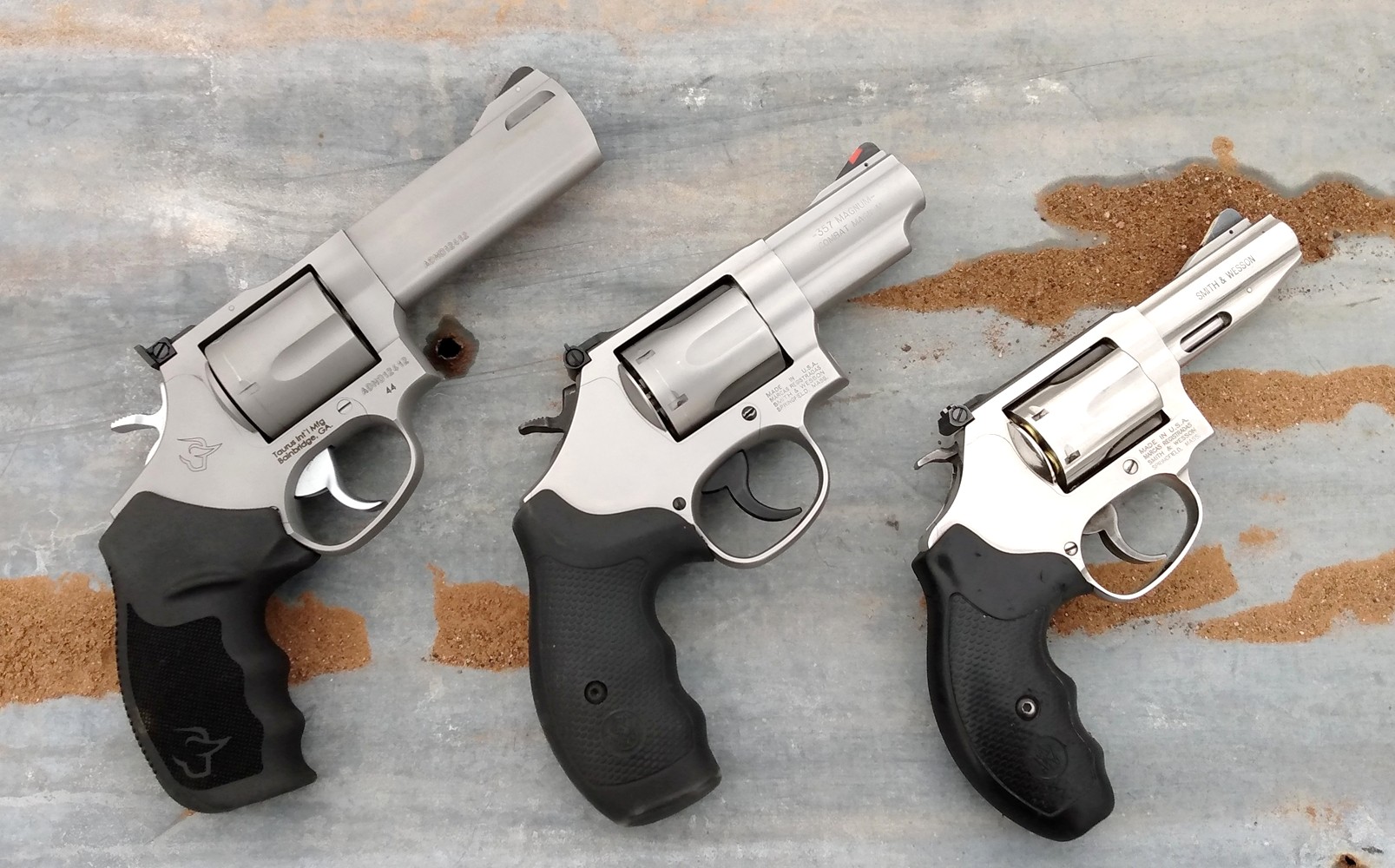
Trail Revolver Trio, from L. to R.:
Taurus Tracker .44; S&W Model 66; S&W Model 632 Carry Comp
|
So there you have it – three trail revolvers covering the spectrum of centerfire
revolver calibers. You could not ask for better friends when exploring the wild
and remote backcountry.


